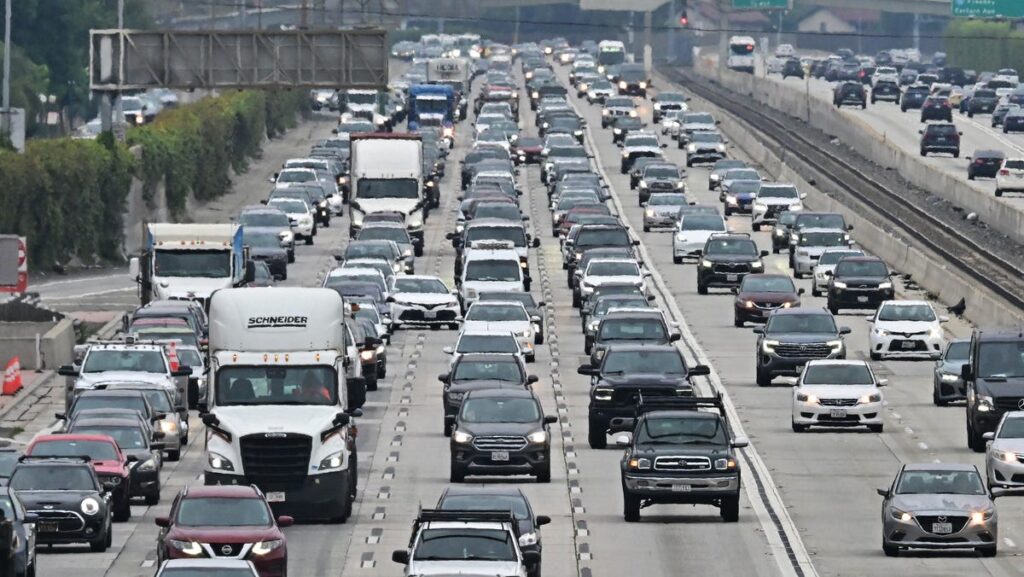World leaders react to President Trump’s automobile tariffs
Canadian, South Korean, German and Japanese world leaders quickly reacted to President Trump’s tariffs on cars.
President Donald Trump said he wants to spur more manufacturing in the United States with a new tariff targeting foreign car imports, set to go into effect Wednesday.
“If they’re made in the United States, there’s absolutely no tariff,” Trump said when he announced the tariffs, later adding, “A lot of companies are going to be in great shape because they’ve already built their plant (in the U.S.) … Others will come into our country and build.”
But defining an American-made car isn’t easy.
Take Honda’s front-wheel drive Acura ADX, which is assembled in Mexico but has 30% of its parts measured by value originating in the U.S. or Canada, according to data from the National Highway Traffic Safety Administration. Meanwhile, the Cadillac CT4, a sedan assembled in the U.S. by one of Detroit’s Big Three automakers, has just 15% of its parts originating in the U.S. or Canada, with another 49% from Mexico.
Out of the roughly 500 carlines listed in the 2025 NHTSA dataset, each had at minimum 20% of their components imported from outside the U.S. and Canada.
“No cars are actually, 100% made in the United States, with parts sourced from the United States,” said Edmunds consumer insights analyst Joseph Yoon. “It’s going to be a big, big deal for the auto industry, globally, if the tariffs are implemented and enforced at face value.”
Which automakers will be hit hardest by tariffs?
Online automotive marketplace Cars.com found just over half of new inventory vehicles had their final assembly in the U.S. About 19% were assembled in Mexico, 4.2% in Canada and 1.4% in China, as previously reported by USA TODAY.
While experts say no automaker will go unscathed by tariffs, companies that import a higher percentage of vehicles will feel more pressure.
General Motors (which imports 49% of its vehicles) as well as Toyota, Hyundai and Nissan (which import more than 50% of their vehicles) are just some of the brands more exposed to tariffs, according to a Thursday note from Bank of America research analyst John Murphy.
Ford may fare better under tariffs, as it only imports a few models worth roughly 20% of its total volumes, according to Murphy. Tesla, which assembles its cars in the U.S. and is run by Trump administration adviser Elon Musk, is also expected to see less of an impact.
But even these American companies rely on imported parts that may be subject to tariffs. NHTSA data shows the Ford F-150, one of the top-selling vehicles in the U.S., is assembled within the country, but roughly 55% of its parts originate from outside the U.S. or Canada. As for Tesla, anywhere from 25% to 40% of its vehicles’ parts originated in other countries.
“Consumers would be surprised to learn that most of the cars that they consider to be import brands are actually made here in U.S. and contribute to the local economy and to the tax base and provide good, American jobs,” said Brian Moody, executive editor for Kelley Blue Book. “Whereas many cars considered domestic brands may or may not be made inside the U.S.”
What do auto tariffs mean for car buyers?
A new car was estimated to cost roughly $48,000 on average as of February, according to Kelley Blue Book. Murphy of Bank of America said car prices could go up as much as $10,000 if automakers pass on the full cost of tariffs to consumers, but a lower – yet still meaningful – $4,500 price increase is more likely.
But that’s only true if the tariffs hold. Trump said the auto tariffs would be permanent throughout his term, but Murphy and other analysts question whether tariffs are being used as a negotiation tactic.
“If this is the case, then the tariffs may still be temporary,” Murphy said in his note.
If the tariffs do stick, experts said they could spur more domestic car manufacturing within the United States and create jobs, something groups like the United Auto Workers union have been pushing for.
Having cars built in the U.S., “I don’t think that’s a bad thing. I think that is good for consumers, and I think that’s good for America and for the workers,” said Moody. “It could be that there’s a long-term benefit here that’s going to make it worth it. But sometimes long term benefits have short term consequences.”
Americans would have to be patient to see those benefits. Wedbush Securities analyst Daniel Ives estimates it would take three years to move 10% of the auto supply chain to the U.S. and cost “hundreds of billions with much complexity and disruption.”
“You can’t build a factory overnight,” Yoon said.
Yoon also questioned how successful tariffs will be in spurring investment within the United States.
Some automakers, including Volvo, have said they are considering moving more production to the U.S., according to Reuters. But if tariffs squeeze automakers’ bottom lines, Yoon said companies may be more inclined to wait for tariffs to ease – either under the current administration, which has already shown it’s willing to adjust tariff plans, or when Trump’s term ends – rather than pour billions of dollars into new plants for tariffs that could go out the window under the next administration.
“Automakers are between a rock and a hard place,” Yoon said.
